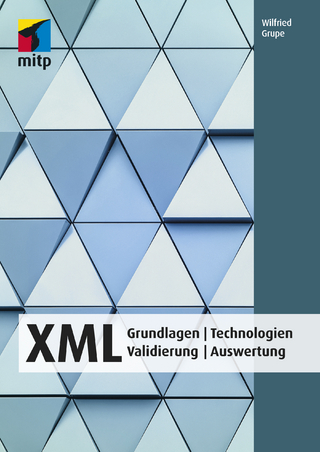
Effective XML
Addison-Wesley Educational Publishers Inc (Verlag)
978-0-321-15040-0 (ISBN)
- Titel ist leider vergriffen;
keine Neuauflage - Artikel merken
Learning the fundamentals of XML might take a programmer a week. Learning how to use XML effectively might take a lifetime. While many books have been written that teach developers how to use the basic syntax of XML, this is the first one that really focuses on how to use XML well. This book is not a tutorial. It is not going to teach you what a tag is or how to write a DTD (Document Type Definition). Instead it's going to tell you when, why, where, and how to use such tools effectively (and equally important when not to use them).Since XML has become a fundamental underpinning of new software systems, it becomes important to ask new questions, not just what XML is, but how does one use it effectively? Which techniques work and which don't? Perhaps most importantly, which techniques appear to work at first but fail to scale as systems are further developed? This book answers these questions. It is not enough to write programs that compile and produce the expected results. It is important to write code that is extensible, legible, and maintainable. XML can be used to produce robust, extensible, maintainable systems.
Elliotte Rusty Harold is an internationally respected writer, programmer, and educator. He is an Adjunct Professor of Computer Science at Polytechnic University in Brooklyn, where he lectures on Java and object-oriented programming. His Cafe con Leche Web site has become one of the most popular sites for information on XML. In addition, he is the author and coauthor of numerous books, the most recent of which are The XML Bible (John Wiley & Sons, 2001) and XML in a Nutshell (O'Reilly, 2002). 0321150406AB06062003
Preface.
Acknowledgments.
Introduction.
Element versus Tag.
Attribute versus Attribute Value.
Entity versus Entity Reference.
Entity Reference versus Character Reference.
Children versus Child Elements versus Content.
Text versus Character Data versus Markup.
Namespace versus Namespace Name versus Namespace URI.
XML Document versus XML File.
XML Application versus XML Software.
Well-Formed versus Valid.
DTD versus DOCTYPE.
XML Declaration versus Processing Instruction.
Character Set versus Character Encoding.
URI versus URI Reference versus IRI.
Schemas versus the W3C XML Schema Language.
I. SYNTAX.
Item 1. Include an XML Declaration.
The version Info.
The encoding Declaration.
The standalone Declaration.
Item 2. Mark Up with ASCII if Possible.
Item 3. Stay with XML 1.0.
New Characters in XML Names.
C0 Control Characters.
C1 Control Characters.
NEL Used as a Line Break.
Unicode Normalization.
Undeclaring Namespace Prefixes.
Item 4. Use Standard Entity References.
Item 5. Comment DTDs Liberally.
The Header Comment.
Declarations.
Item 6. Name Elements with Camel Case.
Item 7. Parameterize DTDs.
Parameterizing Attributes.
Parameterizing Namespaces.
Full Parameterization.
Conditional Sections.
Item 8. Modularize DTDs.
Item 9. Distinguish Text from Markup.
Item 10. White Space Matters.
The xml:space Attribute.
Ignorable White Space.
Tags and White Space.
White Space in Attributes.
Schemas.
II. STRUCTURE.
Item 11. Make Structure Explicit through Markup.
Tag Each Unit of Information.
Avoid Implicit Structure.
Where to Stop?
Item 12. Store Metadata in Attributes.
Item 13. Remember Mixed Content.
Item 14. Allow All XML Syntax.
Item 15. Build on Top of Structures, Not Syntax.
Empty-Element Tags.
CDATA Sections.
Character and Entity References.
Item 16. Prefer URLs to Unparsed Entities and Notations.
Item 17. Use Processing Instructions for Process-Specific Content.
Style Location.
Overlapping Markup.
Page Formatting.
Out-of-Line Markup.
Misuse of Processing Instructions.
Item 18. Include All Information in the Instance Document.
Item 19. Encode Binary Data Using Quoted Printable and/or Base64.
Quoted Printable.
Base64.
Item 20. Use Namespaces for Modularity and Extensibility.
Choosing a Namespace URI.
Validation and Namespaces.
Item 21. Rely on Namespace URIs, Not Prefixes.
Item 22. Don't Use Namespace Prefixes in Element Content and Attribute Values.
Item 23. Reuse XHTML for Generic Narrative Content.
Item 24. Choose the Right Schema Language for the Job.
The W3C XML Schema Language.
Document Type Definitions.
RELAX NG.
Schematron.
Java, C#, Python, and Perl.
Layering Schemas.
Item 25. Pretend There's No Such Thing as the PSVI.
Item 26. Version Documents, Schemas, and Stylesheets.
Item 27. Mark Up According to Meaning.
III. SEMANTICS.
Item 28. Use Only What You Need.
Item 29. Always Use a Parser.
Item 30. Layer Functionality.
Item 31. Program to Standard APIs.
SAX.
DOM.
JDOM.
Item 32. Choose SAX for Computer Efficiency.
Item 33. Choose DOM for Standards Support.
Item 34. Read the Complete DTD.
Item 35. Navigate with XPath.
Item 36. Serialize XML with XML.
Item 37. Validate Inside Your Program with Schemas.
Xerces-J.
DOM Level 3 Validation.
IV. IMPLEMENTATION.
Item 38. Write in Unicode.
Choosing an Encoding.
A char Is Not a Character.
Normalization Forms.
Sorting.
Item 39. Parameterize XSLT Stylesheets.
Item 40. Avoid Vendor Lock-In.
Item 41. Hang On to Your Relational Database.
Item 42. Document Namespaces with RDDL.
Natures.
Purposes.
Item 43. Preprocess XSLT on the Server Side.
Servlet-Based Solutions.
Apache.
IIS.
Item 44. Serve XML+CSS to the Client.
Item 45. Pick the Correct MIME Media Type.
Item 46. Tidy Up Your HTML.
MIME Type.
HTML Tidy.
Older Browsers.
Item 47. Catalog Common Resources.
Catalog Syntax.
Using Catalog Files.
Item 48. Verify Documents with XML Digital Signatures.
Digital Signature Syntax.
Digital Signature Tools.
Item 49. Hide Confidential Data with XML Encryption.
Encryption Syntax.
Encryption Tools.
Item 50. Compress if Space Is a Problem.
Recommended Reading.
Index. 0321150406T08272003
| Erscheint lt. Verlag | 2.10.2003 |
|---|---|
| Verlagsort | New Jersey |
| Sprache | englisch |
| Maße | 235 x 176 mm |
| Gewicht | 581 g |
| Themenwelt | Informatik ► Programmiersprachen / -werkzeuge ► XML |
| Mathematik / Informatik ► Informatik ► Web / Internet | |
| ISBN-10 | 0-321-15040-6 / 0321150406 |
| ISBN-13 | 978-0-321-15040-0 / 9780321150400 |
| Zustand | Neuware |
| Haben Sie eine Frage zum Produkt? |
aus dem Bereich
